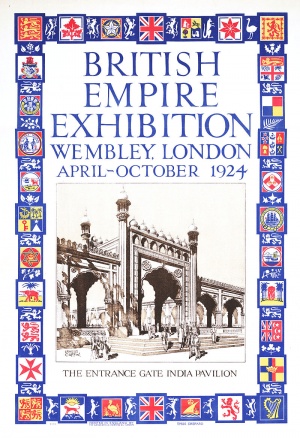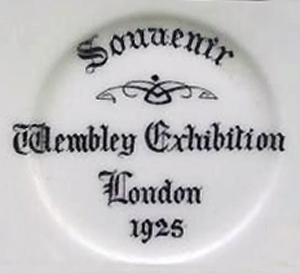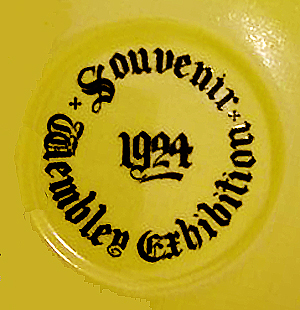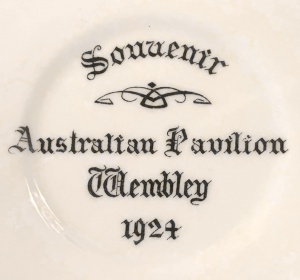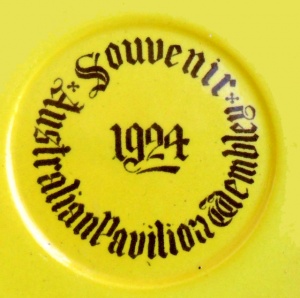Category:Wembley British Empire Exhibition
From Mystic Tea Room
The British Empire Exhibition, a world's fair type event, was held at Wembley Park, Wembley, England from April 23rd 1924 through October 31st 1925.
This is a list of all pages which feature Cup of Knowledge tea leaf reading sets made in England that bear top-marks relating to the British Empire Exhibition of 1924-1925. The commemorative top-mark is only found in the well of the saucers.
Wembley Shapes
The manufacture, decoration, firing, and sale of British bone china at the exhibition was conducted by a collaborative effort of six Stoke-on-Trent potteries, each of whom backstamped their products individually. Regardless of the marking, the British Empire Exhibition cups are for the most part small and rather vertical in form -- midway between standard and demitasse size -- because they were fired in a newly-built replica of a 19th century bottle kiln that had limited interior space. These potteries were known to have made Cup of Knowledge tea leaf reading sets at Wembley:
Wembley Top-Marks
The British Empire Exhibition was held at Wembley, and some cups were marked as souvenir items, with the Wembley location and year date -- but most of the sets were not thus marked, and not every cup design has been found in a Wembley variant. The Wembley top-mark is only found in the well of the saucer. The cups themselves are Cup of Knowledge cartomancy cups and saucers.
The Booths pottery designed its own Wembley souvenir saucer decal, a circular one that perfectly fits the shape of the saucer well. The company also sold its tea cup sets that were specially marked with a saucer-well decal identifying them with the Australian Pavilion at the fair, although the pottery was made in England.
Bridgwood did not use a Wembley souvenir transfer on any of its B.E.E. saucers. The larger-sized sets were marked with the interior Cup of Knowledge design and were not even backstamped Bridgwood, although they are obviously a Bridgwood shape, and the smaller-sized Bridgwood cups were backstamped Bridgwood but their saucers were all marked for the Dunedin Exhibition in New Zealand and were shipped there for sale.
As for Aynsley, oddly enough, although the transfer on the Aynsley branded Cup of Knowledge sets carries a small design element identical to that found in the interior of all Cup of Knowledge cups, the transfer itself is the wrong size for the Wembley saucers and invariably hangs over the well and into the plate area of the saucers. Thus, when the cups are set upon the saucers, fragments of text can be seen, in a most awkward way, as shown.
I have a theory that may explain this, although i have no proof that it is true. Here is my idea:
When the six potteries agreed to join together to build the B.E.E. demonstration kiln and to manufacture tea cups on-site at Wembley, Aynsley commissioned a transfer pattern for the saucers that went with their standard sized tea cups and saucers -- that is, 6-inch saucers, equivalent to ones used with Aynsley's so-called Doris shape cup. However, after the transfers were prepared and the nostalgic bottle kiln was built, it was decided that smaller cups and saucers would make more efficient use of the limited kiln space.
A few Aynsley Doris cups and saucers marked for Wembley have been found over the years, but the vast majority are the small-sized shapes. Therefore, it seems to me that rather than throw away thousands of transfers, someone at Aynsley made the executive decision to use them anyway, even though they absolutely do not fit the small saucers. Despite this aesthetic error, the rarity of the Wembley-marked Cup of Knowledge sets is such that they are considered among the most collectible of tasseomantic items.
catherine yronwode
curator, historian, and docent
The Mystic Tea Room
See Also
- Specially-Marked Commemoratives
- Wembley British Empire Exhibition
- Dunedin Exhibition New Zealand
- Philadelphia Sesqui-Centennial
- Coronation and Royal Visit Commemoratives
Pages in category "Wembley British Empire Exhibition"
The following 37 pages are in this category, out of 37 total.
